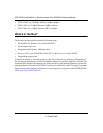
NETGEAR ProSafe 802.11g Wireless Access Point WG302v2 Reference Manual
1-2 Introduction
v1.0, May 2006
• Multiple BSSIDs. Support for multiple BSSIDs. When one AP is connected to a wired
network and a set of wireless stations, it is referred to as a Basic Service Set (BSS). The Basic
Service Set Identifier (BSSID) is a 32-character unique identifier attached to the header of
packets sent over a WLAN that differentiates one WLAN from another when a mobile device
tries to connect to the network.
• DHCP Client and Server Support. DHCP provides a dynamic IP address to PCs and other
devices upon request. The WG302v2 can obtain network information from a DHCP server on
your network. The AP can also act as a DHCP server and provide network information for
wireless clients.
• SNMP Support. Support for Simple Network Management Protocol (SNMP) Management
Information Base (MIB) management.
WG302v2 Key Features
The WG302v2 provides solid functionality, including these features:
• Multiple Operating Modes
– Wireless Access Point. Operates as a standard 802.11b/g wireless access point.
– Point-to-Point Bridge. In this mode, the WG302v2 communicates with another
bridge-mode wireless station.
– Point-to-Multi-Point Bridge. This mode allows the WG302v2 to bridge to several other
access points at the same time.
– Wireless Repeater. In this mode, the WG302v2 operates as both a wireless access point
and a wireless bridge.
• Rogue Access Point Detection. For enhanced security, you can scan the wireless network to
detect rogue access points.
• Hotspot Settings. You can allow all HTTP (TCP, port 80) requests to be captured and
re-directed to the URL you specify.
• Upgradeable Firmware. Firmware is stored in a flash memory and can be upgraded easily,
using only your Web browser, and can be upgraded remotely. You can also upgrade firmware
from the command line interface (CLI) by using TFTP.
• Access Control. The Access Control MAC address filtering feature can ensure that only
trusted wireless stations can use the WG302v2 to gain access to your LAN.
• Security Profiles. When using multiple BSSIDs, you can configure unique security settings
(encryption, SSID, etc.) for each BSSID.


















